|
Entrepreneurial Characteristics and
Decision Making:
Evidence from Jordan

Dima Nabil Sahouri
Ibrahim Issa Rantissi
Samar Jubran Bishouti
Afram Ibrahim Ozgul
Department of Business Administration,
King Talal Faculty of Business and
Technology,
Princess Sumaya University for Technology,
Amman, Jordan

Abstract
The aim of this research is to investigate
the effect of several factors such
as cognitive biases, anchoring, demographic
factors, personality traits, environmental
factors and self assessment on the
quality of entrepreneurial decision
making and to raise awareness about
the entrepreneurial aspects in the
people's mind. This study was based
on owners of Jordan entrepreneurial
companies incubated in Oasis500 and
IPark.

Introduction
The Jordanian markets are limited
because of the small size of the different
types of businesses in the Public
and Private sectors and because the
financial resources are very limited,
in addition to the strong competition
between the many suppliers or providers
of similar products and services.
All the above make it very difficult
for new ideas to be part of the economy
in Jordan. The economy in Jordan is
being affected by all the political
issues surrounded by it such as conflicts
in Syria and occupation in Palestine
and so on.
Jordan faces some difficulties in
exporting products to the regional
markets and has a very high rate of
taxes. The economy is a major issue
when it comes to entrepreneurs starting
their own business. "Now according
to Adam Smith - the Scottish economist
and philosopher considered to be the
father of political economy - the
free economy is based on the system
of natural freedom in which people
act according to their own rules (Ramona,
2011)."
Entrepreneurs mostly work towards
gaining their income rates or for
becoming rich, but each entrepreneur
has a different perspective and different
goals (Markova, 2010). Each one is
willing to satisfy his/her needs and
desires and mostly for a very good
reason. They are also doing a favor
to their society by using new ideas
If a product or service serves a necessity
and solves a problem, people will
use it and it will have a positive
effect on the community."If people
are allowed to use their own resources
they will work in order to get rich
and therefore the society will get
rich as well, this is because the
natural desire of the individual is
to improve their life standards, consequently
to the development of the society
(Ramona, 2011)."
If entrepreneurs are not willing to
take risks, they might never succeed.
Risk takers are the ones who find
new opportunities, the economy is
based on opportunities and on taking
risks "Throughout time the economy
has known many phases, the present
one being the 'new economy'. The main
objective of the 'new economy' is
not the individual as quantity but
the individual as quality. In the
'new economy' people work with their
brain instead of their hands (Zarofshani,
2011)." "When we talk about
the 'new economy' we are talking about
a revolution it is considered to be
the third major economic revolution
this is according to Alexandrova he
considered the first economic revolution
which he titled with the name industrial
revolution, whose core was the mechanization
of labor, it was characterized by
replacing the work of people with
the work of certain machines. The
second economic revolution was focused
on the Automation of the production
process, but with new technologies,
had resulted in scientific development
and have offered solutions for a better
organization of the production process
."The reason why entrepreneurs
fit so perfectly in the 'new economy'
is because entrepreneurs have characteristics
which makes them adaptable to the
'new economy' and these characteristics
are that they are risk takers, they
adapt immediately to changes that
take place in the economy and this
is by being creative and innovative"(Ramona,
2011).
Each citizen who lives in Jordan has
a chance of becoming an entrepreneur
that depends on a variety of factors.
If the entrepreneur doesn't have very
good financial resources they might
fail or at least they won't widen
their business and they won't stay
for a very long period in the market.
"Businesses with weak sales or
poor prospects are more likely to
cut back rather than expand their
business, thereby reducing demand
for credit (Geho, 2013). When the
start-up companies begin growing in
Jordan they face some obstacles in
gaining their economic growth. This
is because Jordan is somehow in the
recession phase so it might be difficult
to reach maximum economic growth.
It is commonly known that "Start-ups
are important for economic growth.
However, start-up rates differ significantly
between countries and within regions
of the same countries (Naude, 2009)".
"Entrepreneurs work and initiate
their new ideas in many different
countries, in different regions and
under different situations. "Entrepreneurship
is linked to the levels of economic
development as well as the cultural
structures. The way entrepreneurs
behave is directly connected to the
cultural behavior, accepted practices
in one country maybe not acceptable
by other cultures in different counties.
In business success is generally indicates
to a firm's financial performance.
It can also be defined from tangible
(objective) points of view such as
revenue or firm's growth, personal
wealth creation, profitability, turnover
(Chowdhury, 2013)."
Literature Review
Entrepreneurship has been defined
as managerial behavior which consistently
exploits opportunities to deliver
results beyond one's own capabilities
(Thompson, 1999). It needs enterprising
people, who are agents of change but
maybe not entrepreneurs in a strict
sense. An entrepreneur is someone
with a vision who spots a new opportunity
and is minded to act on it and start
something.
An entrepreneur is a person who can
detect new business opportunities,
and create a new business with new
creative ideas (Baltar, 2014). He
will do his best to get enough resources
to start a new firm. He has the ability
and ambition to improve his new idea
or invention to make it a successful
innovation. He should also be able
to manage and organize his business
venture. He is ready to challenge
and face all the risks and failures,
in order to be successful and generate
profit. You can find entrepreneurs
in many fields of life; entrepreneurship
is more than just a small business
manager or owner. Entrepreneurs are
individuals who make a difference,
they are people with a clear vision,
ready to make a difference and create
something new (Lahti, 2011). They
know exactly how to deal with new
opportunities, risks and uncertainties
to "creatively create'' new services,
products and organizations. They can
also find new methods for doing business
or ensure the customer's satisfaction.
Entrepreneurs usually use their instinct
to analyze and understand the market
and its needs and try their best to
satisfy them (Barnes, 1984). They
do their work with enthusiasm and
passion to achieve their goals. So,
they usually come up with new creative
inventions and solutions that will
solve many problems or create new
opportunities, and they do their best
to convince the investors and the
people around them to adopt and use
their ideas or inventions, so that
they can create demand for their products,
which will on the long run create
new opportunities and open new doors
which will enhance the economy and
create new job opportunities.
Decision-making processes describe
the common human tendency when making
decisions. Entrepreneurs also should
get all the needed information to
make a certain judgment. This helps
the entrepreneurs to have a clearer
and sufficient view of the market
and its needs and with that they can
build their plan. Of course, as humans,
they might fall in a decision making
trap or judgmental bias (Hammond,
1998).
Most entrepreneurs make their judgment
from decisional shortcuts and use
it to come up with good solutions
most of the time (Lorenge, 2008).
For example, when they interview an
applicant, they base their decision
upon the first impression disregarding
the impressive resume given by the
applicant. This explains how entrepreneurs
go for decisional shortcuts to find
efficient solutions in order to spare
time and effort.
1. Entrepreneurial
opportunity
An entrepreneurial opportunity exists
whenever there is a need, want, problem
or challenge that can be addressed,
solved and or satisfied in an innovative
way.
(http://www.cedsvg.com/LinkClick.aspx?fileticket=WV%2FoEgx2JNQ%3D&tabid=75&mid=565)
Entrepreneurial idea
It is a specific, new way to satisfy
a need or want, overcome a problem
or meet a challenge.
(http://www.cedsvg.com/LinkClick.aspx?fileticket=WV%2FoEgx2JNQ%3D&tabid=75&mid=565)
Figure 1: Entrepreneurship process
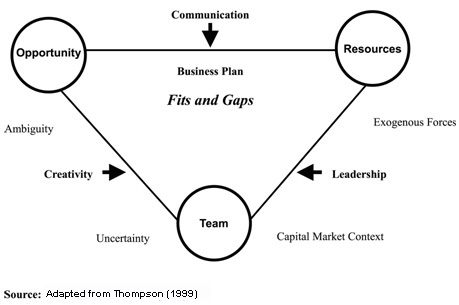
The diagram above (Thompson, 1999)
shows the Entrepreneurship process.
It is based on three main factors
that complement each other: opportunity,
resources and team. All the three
factors should be present and reliable
to have a successful entrepreneurship.
When the entrepreneur finds the opportunity,
he should use his communication skills
to get the resources, and when he
gets the opportunity and the resources
he should use his leadership skills
and creativity to build and manage
his team. Constrained by resource
limitations, especially finance, entrepreneurs
use creativity, social networking
and bargaining to obtain favors, deals
and action (Thompson, 1999). But this
process is affected by many external
factors: ambiguity, uncertainty, exogenous
forces and capital market context.
The entrepreneur should be aware of
each factor and know how to deal with
it to become a successful entrepreneur
(Schumpeter, 2000). This process should
be implemented using a well-designed
business plan to manage and fill all
the gaps between all the three main
factors. It's recommended that the
business plan should be implemented,
monitored and controlled by a specialized
manager, not the entrepreneur himself.
Anchoring
"The anchoring effect is the
phenomenon under which individuals,
when making estimates, rely more on
subjective irrelevant data and information"
(Caputo, 2014).
There are two reasons why anchoring
affects the decisions of the entrepreneurs.
"First, we often develop estimates
by starting with an initial anchor
that is based on whatever information
is provided and adjust from the anchor
to yield a final decision (Caputo,
2014). Adjustments away from anchors
are usually not sufficient (Caputo,
2013).
Anchoring and bias are interconnected
and depend on each other; therefore,
entrepreneurs must take them into
consideration while putting their
study plan. "A bias can be defined
as the human tendency to make systematic
errors in certain circumstances based
on cognitive factors rather than evidence
(Caputo, 2013)." "A biased
managerial decision-making process
can affect a wide range of decisions
and environments, such as groups (Caputo,
2014). For example, it could distort
beliefs affect estimates or valuations
and increase the reliability on subjective
approach (Ramadani, 2009)."
By that we come to the conclusion
that the entrepreneurs must focus
on cognitive bias and a biased managerial
decision making process as it allows
them to have a more balanced view
and helps them also in their researches
to take into consideration some major
factors such as: size of the market,
people's needs and interests and the
estimated life period of the project.
Education
Education is dynamically changing
with time therefore new theories appear,
so entrepreneurs are using the chronologically
based approach education. "That
is, business entry has become one
of the most broadly addressed entrepreneurial
subjects in current curricula (Elmuti,
2011).
People who want to be entrepreneurs
and have the ability to start up their
own business are important. Those
people may be the new leaders, innovators,
problem solvers needed to improve
the Jordan community. Starting from
schools to universities, entrepreneurial
lectures should be given in order
to develop the way they think, and
burnish their ideas, potential, abilities
and talents in order to be the chosen
ones to make a brighter future for
their own benefit and the benefit
of their community. Entrepreneurship
education on the other hand, refers
to a collection of formalized teachings
that inform, train and educate learners
who are interested in setting up a
business. "Entrepreneurship education
assigned as skills that the person
can learn and the characteristics
that can be assured to authorize the
person to develop and create plans"
(Ramayah, 2012), and to start up a
new business.
Education for entrepreneurship means
improving formal knowledge and skills,
such as the willingness to take risk,
self confidence, creativity, the ability
to see the possible outcomes of a
decision, and the willingness to come
up with modern solutions that can
totally develop entrepreneurial conduct
and attitude (taken from "Forging
New Technology Entrepreneurs in the
MENA Region through Education, By:
Laith Kassis"). These acquired
skills and qualities will be useful
when running a company and will have
a positive effect on the environment
as a whole. Entrepreneurial culture
is crucial for encouraging entrepreneurs
in commencing high growth businesses.
The cultural belief of failure has
to be ironed out, a person must learn
from his own mistakes, it is necessary
to fail at least twice in order to
have a better understanding the third
time. An entrepreneur has to know
how to deal with failure and how to
proceed in order to not make the same
mistake twice. The general consensus
is that entrepreneurship education
has a substantial contribution to
the culture of a nation. Entrepreneurship
education should explain topics such
as venture capital, innovation, business
plan writing, marketing, financing,
and so on. It is of paramount importance
to develop the competency and the
entrepreneurial zeal of the students,
as well as to teach them soft skills
in order to help them identify opportunities.
Students should also be prepared in
order to know how to deal with uncertainty
in developing a business, obtaining
financing and having social responsibilities
(Hansen, 2011). The use of guest speakers
or competitions in which they have
to complete business plans are recommended.
The aim of these activities is to
narrow the gap between theory and
practice, in order to create a fun
and rewarding learning experience.
Those activities can be stimulated
by the beneficial method of 'think,
tell, and sell' in order to make participants
think how to act in imperfect information
cases and high risk scenarios Simulations
and interviews with entrepreneurs
can be helpful in order to make participants
consider entrepreneurship as a career
choice. This kind of learning should
include different scenarios, cases,
written role plays and video and live
formats. There are a lot of people
who don't learn in school proper practices
like soft skills, team work, implementing
decisions in real work situations,
collaboration and cooperation (Kolabi,
2012). That's why when students graduate,
they need to go again through a learning
process provided by the companies,
in order to successfully work there.
This learning process may be too short
or insufficient for the employee.
Theoretical Framework
We based our research on this Theoretical
Framework, which summarizes research
study aspects.
Figure 2: Framework

There are many factors that define
an entrepreneur, such as personality
characteristics, self confidence,
risk taking, desire to work, work
orientation, creativity and innovation,
biases and judgmental biases in decision
making like anchoring. There are also
economic factors that contribute to
the success of a start-up, such as
economic strength, level of economic
certainty, the opportunity of making
good wealth. The education factors
are the level of education in general,
entrepreneurship in education centers,
lectures and training about entrepreneurs
for scholars and employees, working
in teams, the teacher's role, the
tools used, motivation theories that
can perfectly be helpful for both
entrepreneurs and the employees that
can work with start-up companies.
There are also external factors like
government regulations, incubators,
business angels, cultural believes
in Jordan. Identifying how these factors
affect the decisions the entrepreneurs
take is the reasoning for our research.
Methodology
In this paper we are aiming to investigate
the effect of several factors such
as cognitive biases, anchoring, demographic
factors, personality traits, environmental
factors and self-assessment on the
quality of the entrepreneurial decision
making.
We briefly state our hypothesis, which
have been derived from the literature
review.
Table 1: Hypothesis
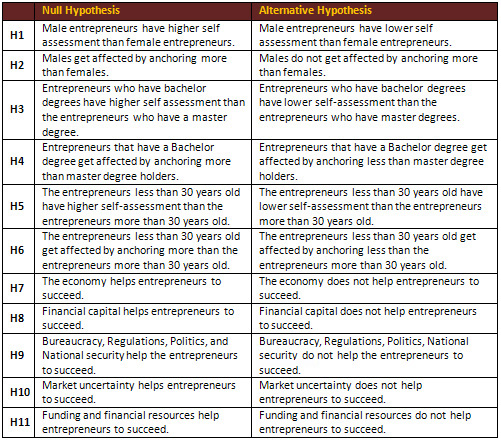
We interviewed two organizations,
which are Oasisi500 and IPark. Oasis500
is a leading and seeding investing
company that has a population of 60
incubated entrepreneurs and IPark
which is an incubation organization
that has a population of 28 incubated
start-up companies. The participants
of both organizations were informed
that they will be interviewed to fill
in surveys. From Oasis500 a sample
of 20 surveys were filled by entrepreneurs
by interviewing them, and from IPark
a sample of 10 entrepreneurs were
interviewed to fill the survey.
A total of 90 surveys were distributed,
we had two surveys: the main survey
was about the entrepreneurs it was
a total of 30 surveys and interviews
that aimed to investigate the demographic
factors, personality traits, environmental
factors, self-assessment and anchoring
on the quality of entrepreneurial
decision making. A total of 60 surveys
were distributed to scholars in Jordanian
universities in order to investigate
the awareness of entrepreneurship
and if they are acknowledge in becoming
a future entrepreneurs.
There are a total of 97 questions
in both surveys, 77 in the entrepreneurial
survey and they were categorized like
this: demographic questions, personality
questions, environmental factors and
challenges, what influenced me to
become an entrepreneur, decision making,
entrepreneurial self assessment, and
anchoring. The 20 questions in the
student's survey indicated the awareness
of the understanding of entrepreneurship.
In our research we used several techniques
when collecting and analyzing data.
We used surveys and interviews. We
used two surveys: the basic one for
the entrepreneurs which measures their
characteristic, their decision making
and the internal and external factors
that affect their start-ups. The second
survey was distributed for university
students, which measures the students'
awareness toward the entrepreneurial
concept and their willingness to be
involved in the entrepreneurial field
to see if there is a relationship
between students' awareness and entrepreneurial
challenges. After collecting the data
we need, we analyzed those data using
Microsoft Office Excel, SPSS and Google
docs.
We used Microsoft Office Excel for
representing results as graphs for
descriptive analysis. From entrepreneurial
survey were as follow, demographic
questions, influences for becoming
an entrepreneur, decision making and
challenges.
We used SPSS statistical program for
measuring entrepreneurial self assessment
and anchoring. The results for anchoring
ranged between 0 and 1, when 0 was
perfect anchoring and 1 stands for
no anchoring.
We used Google Docs for descriptive
data and for building and filling
the survey, either by interviews or
online.
Results
The analysis of this research includes
owners of Jordanian entrepreneurial
companies. The sample was selected
from two of the Jordanian leading
incubation, investing and seeding
companies: IPark and Oasis500. All
of the entrepreneurs available in
these companies were selected in the
sample: 80% of the surveys were filled
by interviewing the entrepreneurs
face to face.
A total of 30 surveys were distributed
to owner managers of the entrepreneurial
companies, because they have enough
knowledge about the overall situation,
performance, processes and goals of
their entrepreneurial companies.
Figures 3 to 9 show the main demographic
characteristics of the survey sample.
Figure 3: Age group
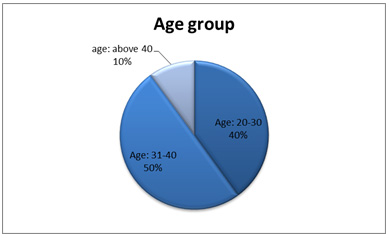
In terms of age, entrepreneurs were
categorized into 3 age groups (20-30,
31-40, above 40). As the data in the
pie chart shows, most of the entrepreneurs
were in the age group 31-40, after
that 20-30, and a low number of people
were above 40.
Figure 4: Gender
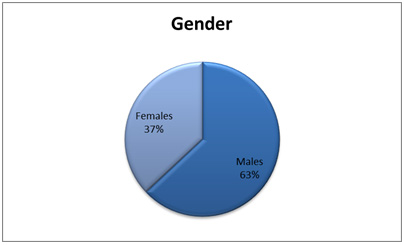
In terms of gender, as the data in the
pie chart above (Figure 4) shows, most
of the entrepreneurs we interviewed
were male (63%) and (37%) females.
Figure 5: Marital status
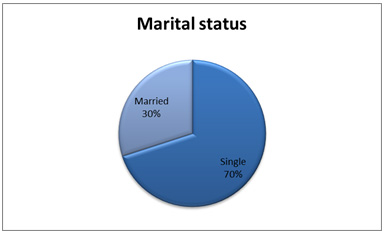
Regarding marital status, as the
data in the pie chart above (Figure
5) shows, most of the entrepreneurs
were single (70%) and only (30%) married.
Figure 6: Education
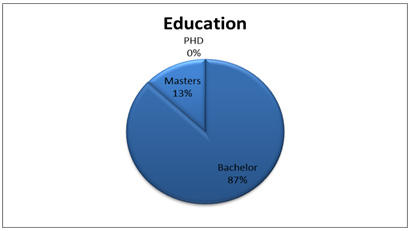
In terms of Education, as the data
in the pie chart above (Figure 6)
shows, most of the entrepreneurs have
bachelor degree (87%), (13%) have
master degree and none of them (0%)
have PHD.
Figure 7: Languages

As the data in the pie chart above
(Figure 7) shows, 73% of the entrepreneurs
speak 2 languages (Arabic and English)
and 27% speak 3 languages (Arabic
English and French). None of them
0% speak only one language.
Figure 8: Working experience

In terms of working experience, entrepreneurs
were categorized according to the
years of working experience into 3
groups (1-9 years, 10-20 years, over
20 years).
As the data in the pie chart (Figure
8) shows, most of the entrepreneurs
(50%) have less than 10 years of working
experience (1-9), after that 40 %
have 10-20 years of working experience,
and only 10% have more than 20 years
of working experience.
Figure 9: Percentages of entrepreneurs
who have another job
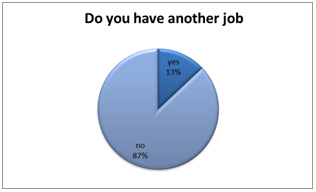
When the entrepreneurs were asked
if they currently have another job,
13% answered yes, but the majority
87% answered no, as shown in the pie
chart (Figure 9).
Figure 10: Break-even and positive
cash flow (in months)
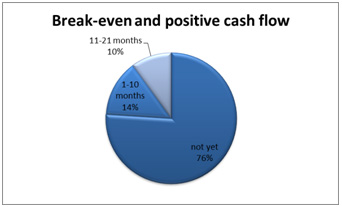
When the entrepreneurs were asked
when they reached the break-even point
and a positive cash flow, the majority
76% said that they didn't reach break-even
point or positive cash flow yet. 14%
said that they reached the break-even
point and received positive cash flow
in the first 10 months and only 10%
said that they reached break-even
point and received positive cash flow
in 11-21 months after starting their
business, as shown in the pie chart
(Figure 10).
Figure 11: Financial capital
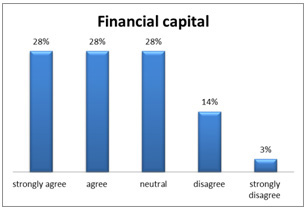
In this section we asked about financial
capital, as figure 11 shows. 28% answered
strongly agree, 28% answered agree,
28% answered neutral, 14% disagree
and only 3% strongly disagree.
Figure 12: Unstable economy
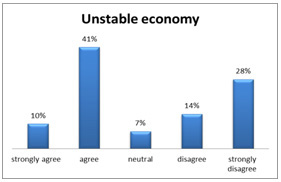
In this section we asked about unstable
economy, as Figure 12 shows. 10% answered
strongly agree, 41% answered agree,
7% answered neutral, 14% disagree
and 28% strongly disagree.
Figure 13: Bureaucracy
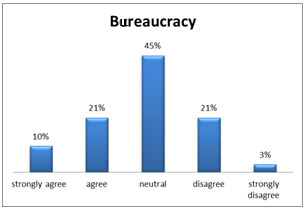
In this section we asked about bureaucracy,
as Figure 13 shows. 10% answered strongly
agree, 21% answered agree, 45% answered
neutral, 21% disagree and 3% strongly
disagree.
Figure 14: Politics
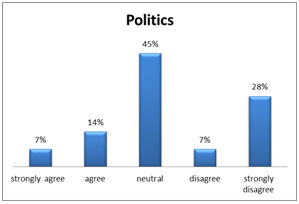
In this section we asked about politics,
as Figure 14 shows. 7% answered strongly
agree, 14% answered agree, 45% answered
neutral, 7% disagree and 28% strongly
disagree.
Figure 15: Regulations
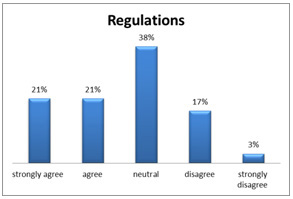
In this section we asked about bureaucracy,
as Figure 15 shows. 21% answered strongly
agree, 21% answered agree, 38% answered
neutral, 17% disagree and 3% strongly
disagree.
Figure 16: National security
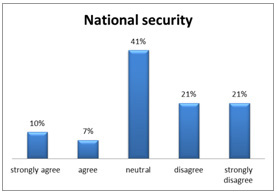
In this section we asked about national
security, as Figure 16 shows. 10%
answered strongly agree, 7% answered
agree, 41% answered neutral, 21% disagree
and 21% strongly disagree.
Figure 17: Funding resources
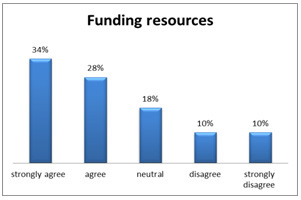
In this section we asked about funding
resources, as Figure 17 shows. 34%
answered strongly agree, 28% answered
agree, 18% answered neutral, 10% disagree
and 10% strongly disagree.
Figure 18: Financial resources
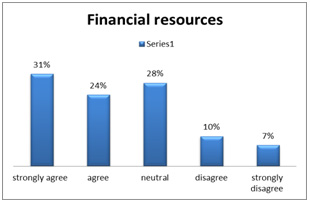
In this question we asked about financial
resources, as Figure 18 shows. 31%
answered strongly Fgree, 24% answered
agree, 28% answered neutral, 10% disagree
and 7% strongly disagree.
Figure 19: Market uncertainty
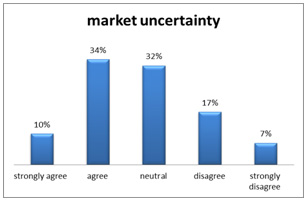
In this question we asked about market
uncertainty, as Figure 19 shows. 10%
answered strongly agree, 34% answered
agree, 32% answered neutral, 17% disagree
and 7% strongly disagree.
Figure 20: Self employed
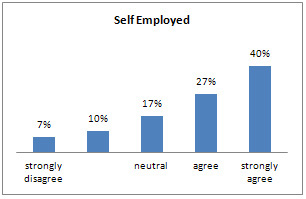
In terms of self-employed, as it
is shown in Figure 20, the majority
of 40% of the entrepreneurs we interviewed
strongly agree on self-employment,
while the minority of 7% strongly
disagreed to the question and 27%
agreed, neutral were only 17% and
10% disagreed.
Figure 21: Public recognition
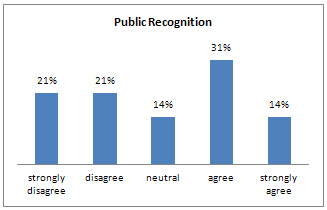
In terms of public recognition, as
shown in Figure 21 the majority of
entrepreneurs agreed, with a percent
of 31%, while 21% disagreed and 21%
strongly disagreed, and the rest of
the percentages were as follows: 14%
neutral and 14% strongly agreed.
Figure 22: Financial rewards
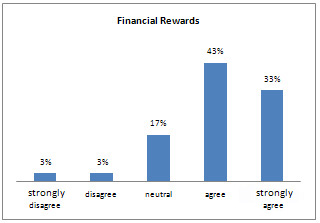
Figure 22 shows what the entrepreneurs
think about financial rewards. The
majority agrees with a percent of
43%, 33% strongly agreed and 17% were
neutral. Only 3% disagreed and 3%
strongly disagreed.
Figure 23: Have a job
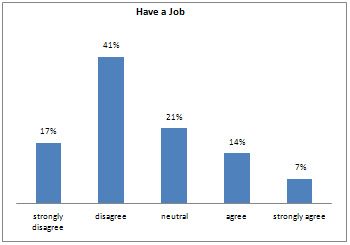
As it is diplayed in Figure 23, we
find that the majority of the entrepreneurs
with a percent of 41% disagreed and
the minority of 7% strongly agreed,
and the rest were as follows: 14%
strongly agreed, 21% neutral and 12%
strongly disagreed.
Figure 24: Need for achievements
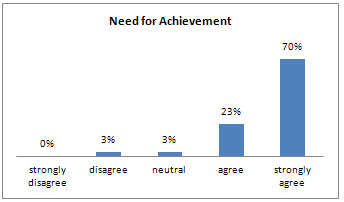
In term of needs for achievement,
as shown in Figure 24, the majority
of 70% strongly agreed, 3% disagreed
and 3% were neutral. The rest were
23% who agreed and none who strongly
disagreed.
Figure 25: Support for more advanced
projects
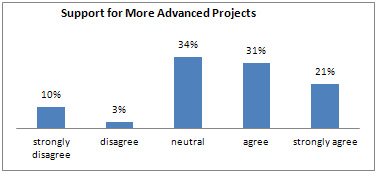
In terms of support for more advanced
projects, as shown in Figure 25, from
the entrepreneurs who were interviewed
the majority of 34% were neutral and
3% disagreed. The rest of 31% agreed,
21% strongly agreed and 10% strongly
disagreed.
Figure 26: Personal fulfillment
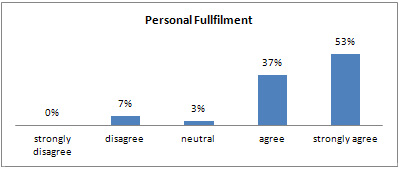
As shown in Figure 26, regarding
personal fulfillment, of entrepreneurs
who were interviewed, the majority
of them stongly agreed with 53% and
37% agreed. In the minority were those
who were neutral 3%, 7% disageed and
none of them strongly disagreed.
Figure 27: Freedom
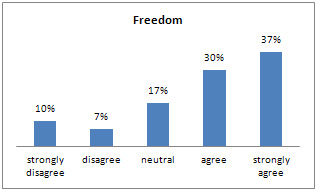
In terms of freedom, as shown in
Figure 27, from the results we got
from the entrepreneurs who were interviewd,
the majority of 37% strongly agreed
and only 3% disagreed. The rest were
as follows: 30% agreed, 10% strongly
disagreed and 17% neutral.
The analysis of this research includes
university students. The samples were
selected from 2 main jordanian universities
(princess sumaya university for technology
and petra university) and a small
random sample from other universities.
A total of 60 surveys were distributed
to the students since they reflect
the jordanian culture that they are
part of.
Figure 28: Students who know the
meaning of entrepreneur
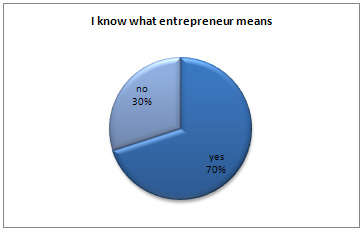
The pie chart above clearly states
that 70% of the students know what
an entrepreneur means and the other
30% never heard about this term.
Figure 29: Team player
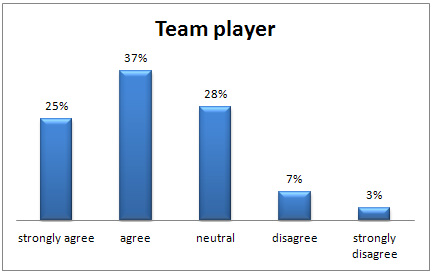
When we asked if the students see
themselves as team players, the responses
were like this, 62% of them agreed
and strongly agreed, 28% of them were
neutral, and only 10% of them disagreed
or strongly disagreed, as the data
in Figure 29 shows.
Figure 30: Risk taker
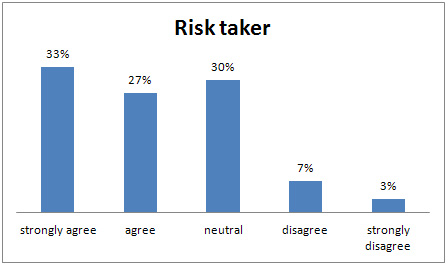
We mentioned in the literature review
that the entrepreneurs should be risk
takers and based on that fact we asked
the students on the scale of 1 to
5 to rate they attitude toward risk.
We found that 33% strongly agreed
that they are risk takers, 27% agreed,
30% were neutral toward risk, 7% disagreed
and 3% strongly disagreed, as the
data in Figure 30 shows.
Figure 31: Failing once is failing
for life
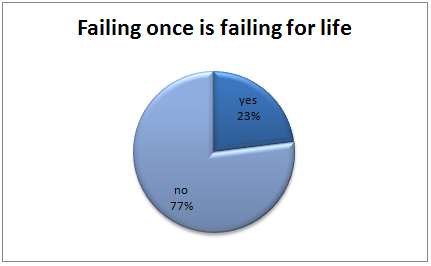
As it is shown in Figure 31, 23%
of the students agreed about failing
once is failing for life, while the
other 77% of our sample did not agree
with this statement.
Figure 32: My university should
provide me training as part of my
studying
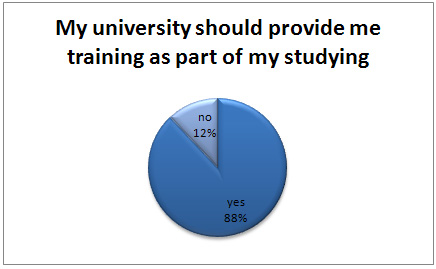
As shown in Figure 32, when students
were asked if they think that their
university should provide them with
training as part of their studies,
88% answered yes and the rest of 12%
answered no.
Figure 33: Do you know if there
are companies that can help me to
become an entrepreneur
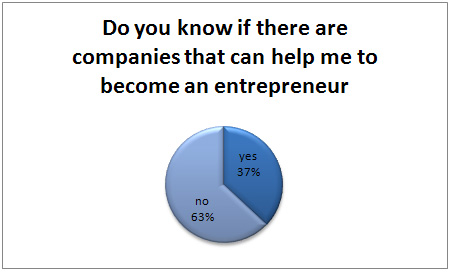
When the students were asked whether
they know if there are companies that
can help them to become entrepreneurs,
only 37% knew about the companies
Oasis500 and Ipark and 63% they didn't
know about those companies, as the
data in the pie chart above shows.
Figure 34: Do I feel content with
the education provided by my university
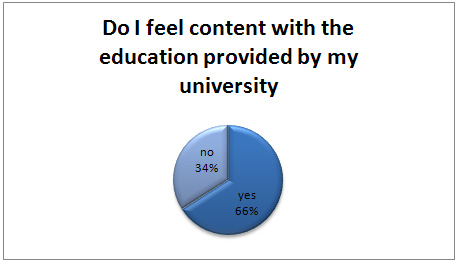
In terms of how content the students
feel with the education provided by
their university, as the data in the
pie chart shows, most of the students
feel content with the education system
provided by their universities (66%)
and 34% don't feel content with the
education system provided by their
universities, as the data in the pie
chart above shows.
Figure 35: Students prefer working
for big companies rather than start-ups
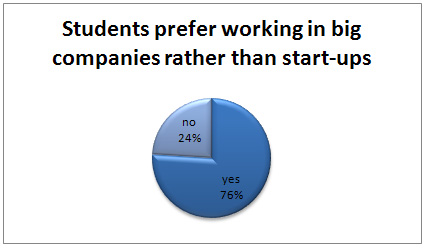
When students were asked whether
they prefer working in big companies
rather than start-ups, 76% answered
yes and the rest of 24% answered no,
as the data in the pie chart above
shows.
Figure 36: Is Jordanian culture
helpful to become an entrepreneur

When students were asked if the Jordanian
culture supports them to become entrepreneurs,
20% answered yes but the majority
80% answered no, as shown in the pie
chart above.
Figure 37: Privileges that students
look for
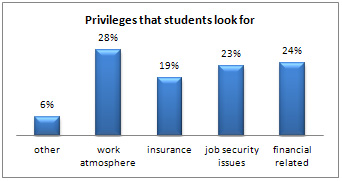
In terms of the privileges that the
students are seeking, we found out
that 28% look for work atmosphere,
23% look for job security issues,
24% are financially related, 19% look
for insurance and 6% are looking for
other privileges, as the data in Figure
37 shows.
Figure 38: Start-up companies
provide the same privileges as big
companies
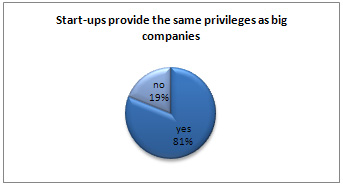
When students were asked if they
considered that start-up companies
offered the same privileges as big
companies, 81% responded yes and 19%
responded no, as shown in the pie
chart above.
The results in the table below were
taken from the entrepreneurial survey
in which we related self-assessment
and anchoring with different demographic
factors.
Table 2: Results table for self-assessment
and anchoring
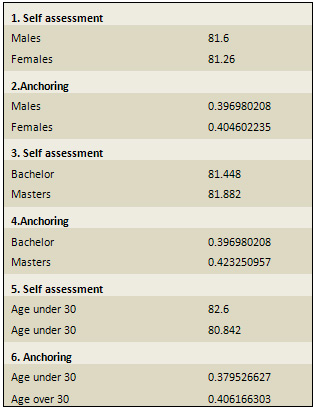
When we took gender to be a factor
of self assessment, we found that
males get higher grades in self assessment
than females, with a score of 81.6
for males and 81.26 for females. When
it comes to anchoring, males were
less affected by anchoring than females.
When we took the level of education
to be a factor of self assessment,
we found that there is a very small
difference, but the holders of bachelor
degrees have a lower assessment capacity
compared with the master degrees holders.
Regarding anchoring, the holders of
bachelor degrees were more affected
from it than the master degree holders.
This supports the idea that the higher
the education, the lower the anchoring
effect and the better the decision
taken.
When we took age to be a factor of
self assessment, we can found that
entrepreneurs under 30 years have
lower self assessment than the entrepreneurs
that are over 30 years old. When it
comes to anchoring, we found that
entrepreneurs under 30 years are more
affected by anchoring than entrepreneurs
over 30 years old. This supports the
argument that the older you become,
the wiser your decisions are.
With the unstable economy as a factor,
only 28% of the entrepreneurs disagreed
that the unstable economy affects
them and a total of 41% of the entrepreneurs
agreed. 28% of the entrepreneurs agree
that one of the main challenges that
they are facing is capital and this
confirms the literature review. 21%
of the entrepreneurs agree that bureaucracy
can be a challenge for them, which
agrees with the literature review.
Regarding market uncertainty, we found
that 44% of the entrepreneurs strongly
agreed that it affects them and only
17% disagreed. The financial resources
turned out to be a major factor for
the entrepreneurs, from the results
we got from the survey 55% strongly
agreed that financial resources are
important and only 10% disagreed.
Table 3: Hypothesis analysis
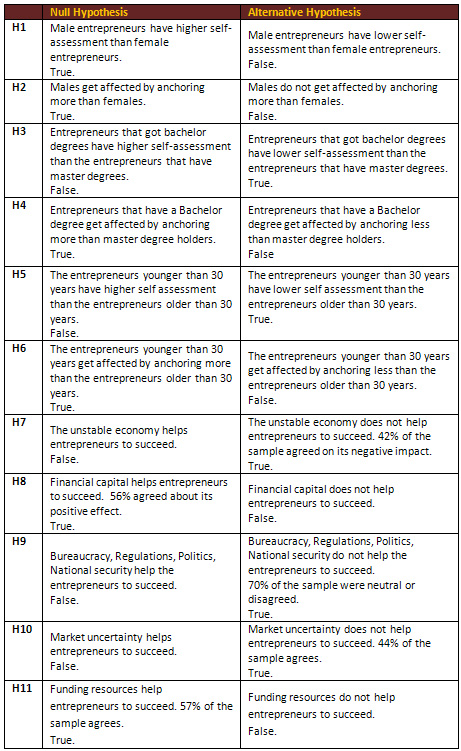
Conclusion
Based on the findings obtained from
the surveys we found out that gender
has a small effect on self assessment
and on anchoring, while education
and age has also a small effect on
self assessment and on anchoring.
A major motivational factor for people
in Jordan is the need for achievement
by contributing to the community.
People in Jordan have little interest
in public recognition. Moreover, the
common personality trait that is shared
among entrepreneurs in Jordan, is
that they are open to new experiences
and being extraverted and enthusiastic.
The thing they consider to be the
least important is being conventional
and uncreative. We also found out
that entrepreneurs follow an organized
plan to reach their goals and they
anticipate important decisions.
We came up with the conclusion that
there is a lack of awareness about
the entrepreneurs, who are they, what
do they do and if there are any companies
that support them. We recommend that
workshops and awareness campaigns
about the entrepreneurial subject
be implemented. These campaigns should
be held in schools and universities.
In this way the student's awareness
will increase towards entrepreneurial
agencies like Oasis500 and iPark.
They will also be better informed
on how to become an entrepreneur.
Students survey indicate that the
majority do not know about entrepreneurial
agencies in Jordan, so if they want
to become entrepreneurs, they have
no idea where to go or where to get
help in adopting, implementing and
funding their ideas in order to benefit
their community.
We recommend to the universities to
include in their study plan training,
in order to help the scholars to have
a good and clear vision about what
is it like to be an entrepreneur.
Jordan highly depends of human capital,
so it is essential to invest in people,
to help them achieve their potential
and stimulate their creativity. Their
ideas will help benefit their society.
Any kind of challenges, like cultural
obstacles, can be opportunities if
the entrepreneur interprets them in
another way, in a positive way that
can help reach the entrepreneurial
goal. All kind of successful entrepreneurs
failed at one time or another, but
the determination helped them reach
their goals. Our recommendation is
for people to believe in themselves
and proceed on their path to a career
that can benefit the society.
References
1. Baltar, F. (2014). Dynamics of
the entrepreneurial process: The innovative
entrepreneur and the strategic decisions.
Review of Business and Finance Studies
, Vol. 5, No. 1.
2. Barnes, J. H. (1984). Cognitive
Biases and Their Impact on Strategic
Planning. Strategic Management Journal
, Vol.5, 129-137.
3. Bazerman, M. H. (2009). Judgment
in Managerial Decision Making. Rosewood:
John Wiley & Sons, Inc.
4. Caputo, A. (2013). A literature
review of cognitive biases in negotiation
processes. International Journal of
Conflict , 374-398.
5. Caputo, A. (2014). Relevant information,
personality traits and anchoring effect.
Int. J. Management and Decision Making.
6. Chowdhury, M. S. (2013). Success
factors of entrepreneurs of small
and medium sized enterprises: Evidence
from Bangladesh. Business & Economic
Research, Macrothink Institute, Inc.,
Vol. 3, No. 2., pp. 2162-4860.
7. Elmuti, D. (2011). Entrepreneur's
personality, education and venture
effectiveness: Perceptions of palestinian
entrepreneurs. Journal of Developmental
Entrepreneurship , Vol. 16, No. 2,251-268.
8. Geho, P. R. (2013). Financing for
small business in a sluggish economy
versus conflicting impulses of the
entrepreneur. Entrepreneurial Executive
, 18: 89-101.
9. Hammond, J.S. (1998). The Hidden
Traps in Decision Making. Harvard
Business School Publishing Corporation
, 84(1): 118-126.
10. Hansen, D.J. (2011). Defragmenting
definitions of entrepreneurial opportunity.
Journal of Small Business Management
, 49(2), pp. 283-304.
11. Kassis, L. (n.d.). Forging New
Technology Entrepreneurs in the MENA
Region.
12. Kolabi, R. M. (2012). Investigating
effect of entrepreneurs personal attributes
and cognitive heuristics on the quality
of entrepreneurial strategic decision
making. Global Business and Management
Research: An International Journal
, Vol. 4, No. 2, pp. 178-192.
13. Lahti, T. (2011). Categorization
of angel investments: An explorative
analysis of risk reduction strategies
in Finland. Venture Capital , Vol.
13, No. 1, 49-74.
14. Lefter, V., M. A. (2009). Employees
motivation theories developed at an
international level. Annals of the
University of Oradea, Economic Science
Series , 18(4): 324-328.
15. Lorange, B. C. (2008). Driving
renewal: The entrepreneur-manager.
Journal of Business Strategy ,Vol.
29 No. 2, pp. 14-21.
16. Markova, S. T., P. M. (2010).
Entrepreneurial finance: angel investing
as a source of funding high-growth
start-up firms. Annals of the University
of Petro?ani, Economics , 10(3), 217-224.
17. Naude, T. G. (2009). Entrepreneurship
and regional economic growth: Towards
a general theory of start-ups. Innovation:
The European Journal of Social Sciences
, Vol. 22, No. 3, 309-328.
18. Ramadani, V. (2009). Business
angels: Who they really are. Strategic
Change , 18(7/8):249-258.
19. Ramayah, T., N. H. (2012). Entrepreneur
education: Does prior experience matter?
Journal of Entrepreneurship Education
, volume 15 .
20. Ramona, R. C. (2011). The importance
of entrepreneurs in the new economy.
Managerial Challenges of the Contemporary
Society , (2): 265-269.
21. Schumpeter, J. A. (2000). Entrepreneurship
as innovation entrepreneurship. Entrepreneurship:
The Social Science View , Vol. , p.
51-75.
22. Thompson, J. L. (1999). The world
of the entrepreneur. Journal of Workplace
Learning: Employee Counselling Today
, 209-224.
23. Zarafshani, K. (2011). Effects
of personality traits on entrepreneurial
intentions: An empirical study in
Iran. International Journal of Management,
Vol. 28 No. 3 Part 1.
|